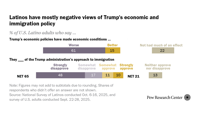
On Tuesday, October 14, Hispanas Organized for Political Equality (HOPE) held a virtual community briefing to present the newly released Economic Status of Latinas National Report, combining data from voices from California, Texas, Florida, New York and Illinois. It also shares different perspectives from Latinas across different jobs, regions and generations.
The “National: Latinas and the Future of American Economic Opportunity” report takes a close look at the current economic challenges and opportunities facing Latinas today, although they are the driving force of in the U.S. economy, contributing $1.3 trillion to the Gross Domestic Product (GDP), reaching record highs in workforce participation, and launching new businesses at a rapid pace. However, persistent challenges such as wage inequality, student debt, limited access to childcare, and restricted business capital continue to hinder their full economic potential.
Speakers who were featured in the presentation included Helen Torres, HOPE CEO; Dr. Elsa Macias, Lead Researcher and Author; and Patty Juarez, Executive Vice President of Public Affairs and External Engagement at Wells Fargo. Together, they discussed national findings from the five states with the largest Latina populations.
“Today marks a milestone for HOPE. Since launching our economic status of Latinas report series in 2013, we have analyzed data and shared insights at the state level. First in California and then most recently in New York. But this year, for the first time, we've taken our research nationally. The “National Economic Status of Latina Report” connects data and community voices from across the country to tell a fuller story of Latinas' contributions, challenges, and potential,” Torres said.
The state of the Latino community
According to the report, many families are dealing with economic uncertainty caused by increasing living expenses, wages that haven’t kept up, barriers to education, healthcare, and housing. For many Latino individuals, this is a very challenging time as immigration raids have also created fear and instability in schools, workplaces and in several communities in Los Angeles County. First-generation students are feeling the impact of reduced investment in public higher education, which is limiting their opportunities. At the same time, shifts in healthcare policy and coverage are reshaping the safety nets that communities have long depended on.
Growth and Changes in the Population
When it comes to Latino individuals, they are the second-largest demographic group in the U.S.. According to the report, in 2024, they increased 20% of the country’s population and is expected to increase to nearly 27% of the total population by 2060.
Additionally, Spanish is now the second most spoken language in the U.S., after English, with nearly 44.9 million speakers aged five and older as of 2024. Hispanic Gen Z and Gen Alpha populations are especially large in California and Texas, meaning many Latinos from these states will enter the workforce over the next decade, further strengthening their role in driving the U.S. economy. “We are excited to share that Latinas are powering America’s economic future. Our influence is enormous, and our power continues to grow,” said Juarez.
Barriers holding back potential
The “National: Latinas and the Future of American Economic Opportunity” report emphasizes that Latinas are younger than any other major demographic group and are increasingly college-educated, launching businesses at record rates, and stepping into elected and corporate leadership roles. In California, 18.6% of Latina women have a college degree or higher and 13.3% of them also own small businesses.
However, the barrier that Latina workers currently face is that they are not being paid enough of what they deserve. Earlier this month, Justice for Migrant Women, a national non-profit organization, published a new report marking the tenth anniversary of Latina Equal Pay Day. The report sheds light on the persistent wage gap Latinas face, revealing they earn only 54 cents for every dollar paid to white, non-Hispanic men. This figure includes Latinas working part-time, seasonally, part-year and in the gig economy.
According to the Institute for Women’s Policy Research, Latinas faced the worst wage gap in California. Based on trends from 2002 to 2022, it will take until 2207 for all Latinas with earnings to reach pay equity with white, non-Hispanic men, and until 2171 for full-time, year-round working Latinas.
Wealth and Poverty
For Latinos, the official poverty rate dropped from 16.6% in 2023 to 15% in 2024, continuing the steady decline since the start of the pandemic. In 2023, the official poverty rate for Latinas was 50% higher than the national rate of Asian and White populations. Additionally, Latinas experience higher poverty rates than Latino males in all age categories.
Between 2019 and 2022, the wealth of Latino households also grew by 38%, accounting for only 4% of the nation’s total household wealth of $139.1 trillion, compared to the White household wealth, which increased by 29%, accounting for 85% of the total household wealth.
Disconnection and financial insecurity
“The fact of the matter is, we are living through a time where we're balancing a lot. I know when HOPE started our college program and we asked the college participants what are some of their top concerns and the number one concern they vocalized to us was, if I can't contribute to my family income, are my parents going to be okay. You often don't get that from other communities. So our family values the importance of not only thinking about our individual finances, we see it as family finance and that is critically important,” Torres shared.
The report highlights that Gen Z Latinas from ages 18–24 face challenges in education and employment. Many young participants also spoke about the lack of a financial safety net that could help them bridge the gap between education and career transitions.
Alexandra, a full-time student in California working multiple part-time jobs, said that her peers “who don’t come from the same [working class] background seem to have more options.” Another participant noted that her peers who were more financially secure also had stronger social networks to tap for job opportunities, connections she didn’t have.
These findings emphasize the need for policies and programs that specifically support first-generation college students and workers, ensuring they have the financial tools, career pathways, and networks to thrive.
Latina-owned business
Latina entrepreneurship is on the rise; nearly 2.4 million Latina-owned businesses generated over $184.8 billion in revenue and employed close to 900,000 people in 2022.
Millennial Latinas own approximately half of all Latina-owned non-employer firms. However, Latina-owned firms are less likely to have employees compared to the national average of 83.5%, and they generate significantly less revenue than employer firms, earning only 79% of the revenue that White women-owned non-employer firms earn.
Despite their successes as business owners, Latina entrepreneurs face many barriers, such as being the sole owners of their business, accessing capital, establishing their businesses and building their knowledge base on the topic. Susana, who is one of the many voices who contributed to the data, said that the difficulty of knowing what to charge for her services was a challenge, explaining that “getting paid what you’re worth is a learning process.”
According to the report, Latina-owned businesses are overrepresented in industries that tend to generate lower revenues, such as personal care, cleaning and laundry services, as well as administrative and support services.
Latina entrepreneurs are also highly represented in Health Care and Social Assistance, as well as Professional, Scientific and Technical Services – sectors projected to see strong job growth over the next decade.
To read the full report, click here.











(0) comments
Welcome to the discussion.
Log In
Keep it Clean. Please avoid obscene, vulgar, lewd, racist or sexually-oriented language.
PLEASE TURN OFF YOUR CAPS LOCK.
Don't Threaten. Threats of harming another person will not be tolerated.
Be Truthful. Don't knowingly lie about anyone or anything.
Be Nice. No racism, sexism or any sort of -ism that is degrading to another person.
Be Proactive. Use the 'Report' link on each comment to let us know of abusive posts.
Share with Us. We'd love to hear eyewitness accounts, the history behind an article.